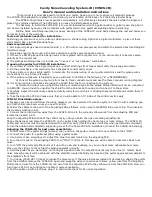
Setting
LT5
70
Hauser
6.3
Indicator adjustment
The following are the three ways in which the indicator on a level gauge can be adjusted;
however, the indicator is operated using the same procedure:
• Fill the tank with actual liquid and calibrate the indicator to the measured volume
• With the tank empty, calibrate the indicator using formulaic calculations
• Fill the tank with water and calibrate the indicator to the measured volume
6.3.1
Calibration using actual measuring liquid
Measure the surface level of the actual liquid two to three times using a measuring tape
that has been certified by a public institution for accuracy within ±0.3 mm (0.01 in)
(however, ±1.2 mm (0.05 in)/10 m (32.81 ft)) to obtain accurate data, and then set to
that value.
6.3.2
Calibration through calculation for an empty tank
• Determine Lf from the equation below when the tank is empty and set the indicator to
that value.
• When surface level Lf is reached, the float will begin to float, the gauge will begin to run,
and it will continue to indicate the accurate surface level (see graphs 1 and 2).
1.
Float draft when the tank is empty
h
2
Lf =
+
S
V
2
W - T
ρ
-
= 80.11 mm
Float diameter
D
400 mm (15.75 in)
Float height
h
200 mm (7.87 in)
Float mass
W
3
300 g (18.3 lb)
Float volume
V
19
200 cm
3
Waterline cross
section
S
1
256.64 cm
2
Tape tension
T
1
200 g (2.65 lb)
Density limits
ρ
1 g (0.002 lb)/cm
3
Lf can be calculated by substituting density into the above equation.
If a float is being installed to a spherical tank away from the tank's center line, add Lx,
which can be determined from the below equation, to Lf in 2 above.
Lx =
D
2
-
- S²
D²
4
Lx
Correction amount for level indication for deviation
caused by float installation
D
Diameter of a spherical tank, etc.
S
Deviation distance from the center of the tank to the
center of the float (mm)
















































